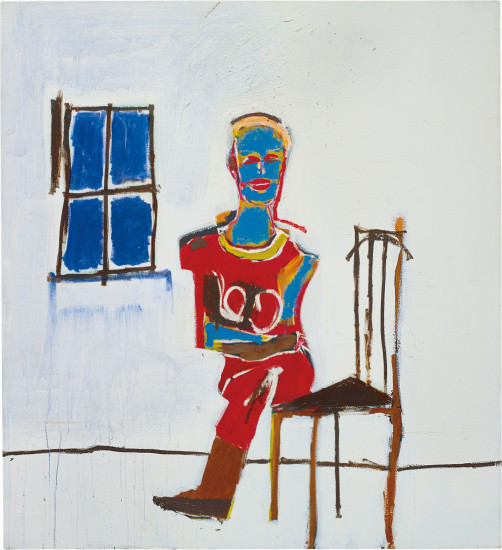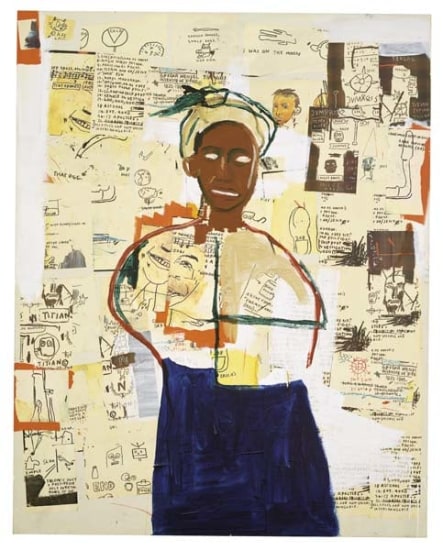Jean-Michel-Basquiat Untitled 1981 acrylic, oilstick on canvas 50 1/2 x 88 in. (128.5 x 223.5 cm.) Signed and dated “Jean Michel Basquiat 81” on the reverse.
Provenance Diego Cortez, New York Galerie Bruno Bischofberger, Zurich Private Collection, acquired directly from the above Exhibited Hannover, Kestnergesellschaft, Jean-Michel-Basquiat: To Repel Ghosts, November 28, 1986 – January 25, 1987 Pully/Lausanne, FAE Musée d’art contemporain, Jean-Michel-Basquiat, July 9 – November 7, 1993 Trieste, Civico Museum Revoltella Galleria d’Arte Moderna, Jean-Michel-Basquiat, May 15 – September 19, 1999 Lugano, Museo d’Arte Moderna, Jean-Michel-Basquiat, March 20 – June 19, 2005 Basel, Fondation Beyeler, Jean-Michel-Basquiat, May 9 – September 5, 2010 Paris, Musée d’Art Moderne de la Ville de Paris, Jean-Michel-Basquiat, October 15, 2010 – January 30, 2011 Literature C. Michetti-Prod’Hom, A. Affentranger-Kirchrath, Jean-Michel-Basquiat, exh. cat., FAE Musée d’art contemporain, Pully/Lausanne, 1993, p. 24 (illustrated) L. Marenzi, Jean-Michel-Basquiat, Milan: Charta Edizioni, 1999, pp. 16-17 (illustrated) Jean-Michel-Basquiat, exh. cat., Civico Museum Revoltella Galleria d’Arte Moderna, Trieste, 1999, pp. 16-17 (illustrated) R. Marshall J. Prat, Jean-Michel-Basquiat, Paris: Galerie Enrico Navarra, 2000, vol. II, p. 70, No. 6 (illustrated) Jean-Michel-Basquiat, exh. cat., Museo d’Arte Moderna, Lugano, 2005, p. 21, no. 3 (illustrated) R. Chiappini, Jean-Michel-Basquiat, Skira: Milano, 2005, p. 21, no. 3 (illustrated) D. Buchhart, S. Keller, G. O’Brien, R. Storr, Jean-Michel-Basquiat, exh. cat., Fondation Beyeler, Basel, 2010, p. 25, no. 16 (illustrated) D. Buchhart, G. O’Brien, J. Schuhl, R. Storr, Basquiat, Jean-Michel-Basquiat, exh. cat., Musée d’Art Moderne de la Ville de Paris, Paris, 2011, p. 29, no. 15 (illustrated) Catalogue Essay With fury in his paintbrush, Jean-Michel-Basquiat descended upon the art world in the early 1980s as a vital storm, a revolutionary by simple virtue of the intense vitality of his complex and complicated artistic energy. While many struggled to understand the importance of his remarkably new forms, others quickly realized the impact that Basquiat would have upon the art world long after his premature death in 1988. Basquiat’s early work in particular exemplifies his sophisticated and revelatory examination of the history of the Americas. A public anatomization of his complex biography lent itself to controversy in his final products, with his work often showcasing not only his own struggle to understand himself, but also those who he considered his heroes and personal icons. Untitled, 1981, is Basquiat in his righteously angry prime, his youthful vigor begetting a masterwork of societal critique only executable by the hand of an artist so uniquely talented. It would be insufficient to discuss this marvelously radical piece without touching upon the biographical and ideological forces that gave rise to Basquiat’s work. As a child of New York in the 1960s and 1970s, Basquiat personally contended with the challenges of a global cosmopolitan with two ancestral national identities, Haitian and Puerto Rican. He was instilled with the nuances of cultural differentiation early on in his life and was exposed to both the challenges of the struggle for racial equality and the wealth of his diverse heritage. He harnessed these differences to a brilliant degree, establishing his fluency in French, English, and Spanish by age eleven. In addition, his fascination with the universals of human knowledge created lasting obsessions, from the natural sciences to history. Astronomy, chemistry, biology, anatomy—all would become ripe subject matter. Perhaps most saliently, he trained his intellect toward self-expression: his skills in drawing and painting were entirely self-taught, a remarkable marriage of observational discipline and extraordinary creativity. As half of the graffiti duo SAMO in the late 1970s, Basquiat’s racial awareness took the public stage, his urban poetry covering the sides of buildings in Brooklyn and downtown New York City. In this period, Basquiat’s growing
Jean-Michel-Basquiat Untitled 1981 acrylic, oilstick on canvas 50 1/2 x 88 in. (128.5 x 223.5 cm.) Signed and dated “Jean Michel Basquiat 81” on the reverse.
Provenance Diego Cortez, New York Galerie Bruno Bischofberger, Zurich Private Collection, acquired directly from the above Exhibited Hannover, Kestnergesellschaft, Jean-Michel-Basquiat: To Repel Ghosts, November 28, 1986 – January 25, 1987 Pully/Lausanne, FAE Musée d’art contemporain, Jean-Michel-Basquiat, July 9 – November 7, 1993 Trieste, Civico Museum Revoltella Galleria d’Arte Moderna, Jean-Michel-Basquiat, May 15 – September 19, 1999 Lugano, Museo d’Arte Moderna, Jean-Michel-Basquiat, March 20 – June 19, 2005 Basel, Fondation Beyeler, Jean-Michel-Basquiat, May 9 – September 5, 2010 Paris, Musée d’Art Moderne de la Ville de Paris, Jean-Michel-Basquiat, October 15, 2010 – January 30, 2011 Literature C. Michetti-Prod’Hom, A. Affentranger-Kirchrath, Jean-Michel-Basquiat, exh. cat., FAE Musée d’art contemporain, Pully/Lausanne, 1993, p. 24 (illustrated) L. Marenzi, Jean-Michel-Basquiat, Milan: Charta Edizioni, 1999, pp. 16-17 (illustrated) Jean-Michel-Basquiat, exh. cat., Civico Museum Revoltella Galleria d’Arte Moderna, Trieste, 1999, pp. 16-17 (illustrated) R. Marshall J. Prat, Jean-Michel-Basquiat, Paris: Galerie Enrico Navarra, 2000, vol. II, p. 70, No. 6 (illustrated) Jean-Michel-Basquiat, exh. cat., Museo d’Arte Moderna, Lugano, 2005, p. 21, no. 3 (illustrated) R. Chiappini, Jean-Michel-Basquiat, Skira: Milano, 2005, p. 21, no. 3 (illustrated) D. Buchhart, S. Keller, G. O’Brien, R. Storr, Jean-Michel-Basquiat, exh. cat., Fondation Beyeler, Basel, 2010, p. 25, no. 16 (illustrated) D. Buchhart, G. O’Brien, J. Schuhl, R. Storr, Basquiat, Jean-Michel-Basquiat, exh. cat., Musée d’Art Moderne de la Ville de Paris, Paris, 2011, p. 29, no. 15 (illustrated) Catalogue Essay With fury in his paintbrush, Jean-Michel-Basquiat descended upon the art world in the early 1980s as a vital storm, a revolutionary by simple virtue of the intense vitality of his complex and complicated artistic energy. While many struggled to understand the importance of his remarkably new forms, others quickly realized the impact that Basquiat would have upon the art world long after his premature death in 1988. Basquiat’s early work in particular exemplifies his sophisticated and revelatory examination of the history of the Americas. A public anatomization of his complex biography lent itself to controversy in his final products, with his work often showcasing not only his own struggle to understand himself, but also those who he considered his heroes and personal icons. Untitled, 1981, is Basquiat in his righteously angry prime, his youthful vigor begetting a masterwork of societal critique only executable by the hand of an artist so uniquely talented. It would be insufficient to discuss this marvelously radical piece without touching upon the biographical and ideological forces that gave rise to Basquiat’s work. As a child of New York in the 1960s and 1970s, Basquiat personally contended with the challenges of a global cosmopolitan with two ancestral national identities, Haitian and Puerto Rican. He was instilled with the nuances of cultural differentiation early on in his life and was exposed to both the challenges of the struggle for racial equality and the wealth of his diverse heritage. He harnessed these differences to a brilliant degree, establishing his fluency in French, English, and Spanish by age eleven. In addition, his fascination with the universals of human knowledge created lasting obsessions, from the natural sciences to history. Astronomy, chemistry, biology, anatomy—all would become ripe subject matter. Perhaps most saliently, he trained his intellect toward self-expression: his skills in drawing and painting were entirely self-taught, a remarkable marriage of observational discipline and extraordinary creativity. As half of the graffiti duo SAMO in the late 1970s, Basquiat’s racial awareness took the public stage, his urban poetry covering the sides of buildings in Brooklyn and downtown New York City. In this period, Basquiat’s growing

.jpg)









Testen Sie LotSearch und seine Premium-Features 7 Tage - ohne Kosten!
Lassen Sie sich automatisch über neue Objekte in kommenden Auktionen benachrichtigen.
Suchauftrag anlegen